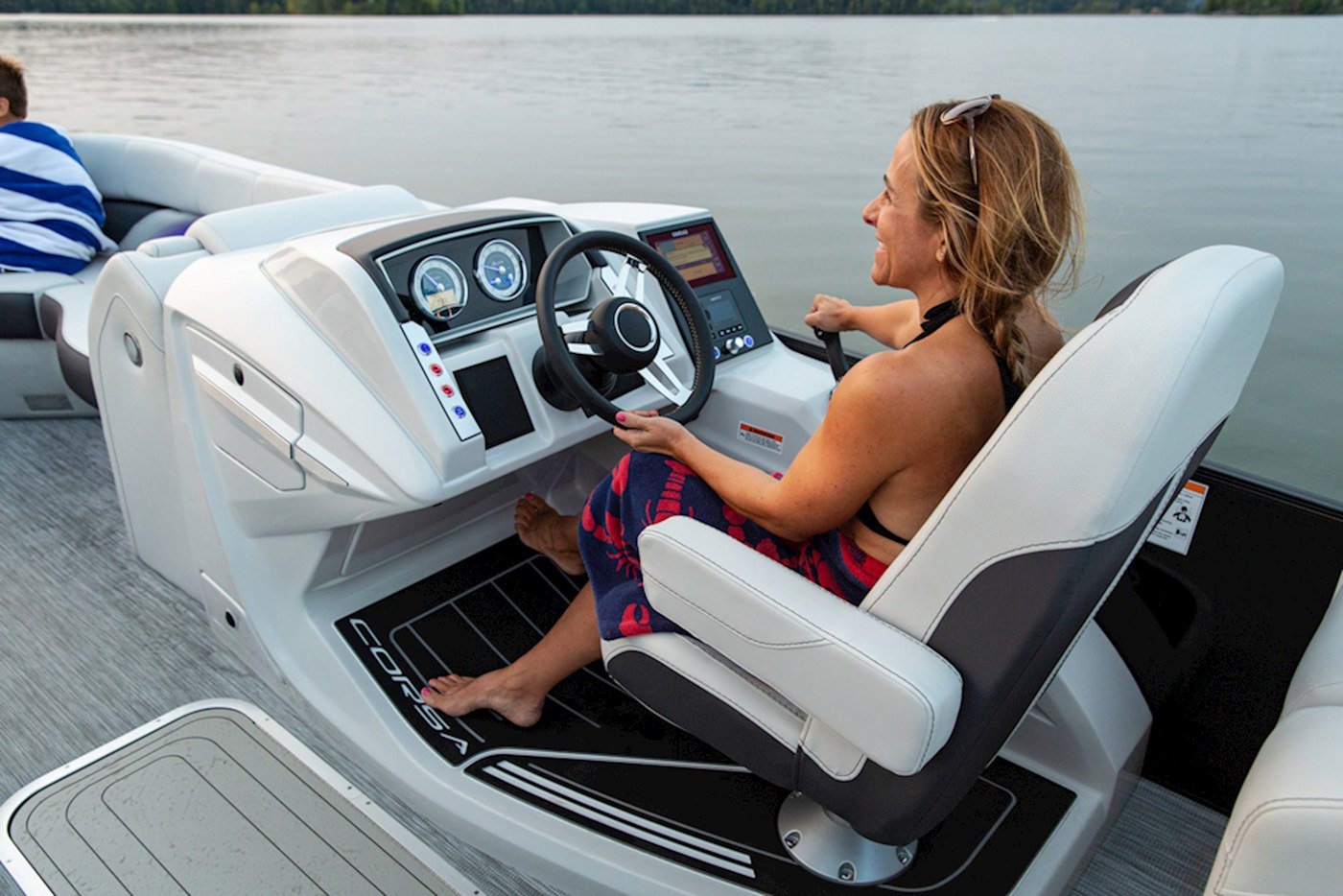How to Trim Your Pontoon Boat: A Step by Step Guide
Picture this, you’ve taken delivery of your new pontoon boat. This is your first boat, and you’ve not been this excited for summer since you were a kid. Your dealer walks you through the boat and takes you on a test run.
The keys are yours, and it’s time to take your crew out for the maiden voyage. You’ve got all the boat gear ready and loaded. You also took the time to learn about boater’s safety well before this moment.
You jump on board, flip on the battery switch, attach the emergency stop lanyard, and everyone gets seated. What’s your next move? Turning the boat on? Checking the engine? Opening the bimini?
If you’ve come to this moment, there’s something I want you to consider, and that’s the trim level of the motor. The next move I make on my own pontoon boat is to make sure the engine is trimmed in the down position.
Not sure what trim means or how it affects your boat’s performance? That’s ok, I'm going to explain everything you need to know about the trim function on your pontoon boat. This feature affects performance and safety, so it’s important to know how to use it.
How to Trim Your Boat
Ryan with Barletta Boats explains how to properly trim your pontoon boat
What Is Trim and Where is it Located?
To trim the motor means to move it up and down. When you trim an outboard motor up, it moves the lower unit (bottom of the engine including the propeller) away from the boat. When you trim down, it brings the lower unit back towards the boat.
You can perform this function using a button located on the throttle of your pontoon boat. This button usually has an up and down arrow on it and is located in a place where your right thumb can easily reach it while your hand is on the throttle.
There will be at least one gauge on your helm that lets you know where your trim sits. It will fluctuate as you move the motor up and down. Once you get familiar with this function, you will also be able to feel, hear, and see the motor being trimmed.
When trimming the engine, you will hear a whining noise. Once it's all the way down, the pitch will change as a signal that it cannot go down any further, and you may take your thumb off the button.
Just the same, if you trim the engine all the way up while it’s running, it will become substantially louder. You don’t want the engine all the way out of the water while it’s running, so if you hear the engine exiting the water, make sure to trim back down immediately.
There are two main reasons you will trim the engine. When in shallow water at low speeds, you will trim the motor up to protect the lower unit from hitting the ground.
You will also utilize this function so that the boat and motor operate at peak performance. Once you get experienced using the trim function, you can manipulate the engine to get more speed, a smoother ride, and on plane quickly.
Adjusting Trim in Shallow Water
The more obvious use for the trim function is to protect the lower unit and propeller from hitting bottom in shallow water. You would do this by trimming up in shallow spots while traveling at slow speeds.
This comes in handy when entering shallow channels, parking in a shallow area, or beaching the boat. There are many other instances you might encounter where the body of water you’re on becomes shallow, so make sure you are aware of these areas before you start cruising.
An example of using trim in this way is when I dock my pontoon boat. The area surrounding my pier is about three feet deep. I approach the dock slowly with the trim lifted up just enough to not graze the bottom.
Once I’ve tied up the boat and have turned it off, I trim the motor all the way out of the water and store it that way until I take the boat out again. Doing so will extend the life of your lower unit and propeller.
It’s important to protect the propeller from hitting inanimate objects because a damaged prop can hinder the performance of your boat. This is why knowing how to trim the engine is such an important function to be educated on.
If you plan to park your boat with the engine trimmed all the way up as I do, make sure to trim it back down before you start the boat for your next ride. You don’t want to let the engine run with the lower unit out of the water for long periods of time.
If the engine is running and not getting water circulated through it because the lower unit is up out of the water, you do run the risk of overheating. If you notice the engine is out of the water while running, trim it down quickly, and you should be just fine.
Using Trim for Peak Performance
Another use for the trim function is to reach peak performance while underway. The position of the engine will affect things like speed and the quality of the ride. Learning how to manipulate the trim is a great way to get an even better ride out of your pontoon boat.
Let’s break down the factors behind using the trim function to reach peak performance. First, it’s important to know that every boat and situation is different when it comes to trimming for performance.
The size of the boat, weight on board, horsepower, and water conditions will affect how the boat performs. Meaning, you could trim the engine at a certain speed, and the ride could feel different if any of these factors are different from the last time you trimmed in this manner.
You can use the trim function to achieve higher speeds; you can also get a smoother ride, and even conserve fuel. Before I explain how this happens, I want you to know what the term on plane means.
Getting the boat on plane or planed out simply means getting the right part of the boat on the surface of the water while running. The boat performs optimally when it’s on plane and trim plays a big role here.
As you trim the motor up it causes the prop to move away from the boat and in turn, the bow angle upwards. When you’re sitting flat in the water, start with the trim all the way down. Once you accelerate, the bow creates a wall of water, if you trim up, the boat lifts up and out of the wall of water and gets on plane for a smooth ride.
Once the bow is up above that wall of water and you continue to accelerate with the trim up, you will encounter less friction. Less friction equals better performance such as speed, fuel economy, and a smoother ride because your boat is working less hard to get through the water.
Getting on plane is the goal, once you’re there and are cruising comfortably, you can stop trimming the engine. Remember, if you trim up and the prop comes out of the water, don’t be alarmed, just start trimming back down immediately. This is called blow out and it won’t hurt the engine for a short amount of time.
As you slow down, you would trim the motor back down accordingly. Remember, you want to take off with the engine trimmed at zero, then work your way up as you accelerate.
The goal for trimming the motor while underway is to find the optimal running angle at every speed. That said, every speed has a prime trim setting and knowing this will come with practice because as I mentioned, every boat is different.
Practicing How to Trim Will Make Perfect
Now that I’ve explained the two main functions of the trim button on your pontoon boat, it’s time to practice. I highly recommend going out in the middle of your body of water on a calm day with little boat traffic and practicing how to trim the engine.
Once you begin, you will learn how to trim using feel, sight, and sound. You will feel the boat plane out and the ride become smoother. You will also feel the engine become faster with the proper trim angle.
Start with the trim all the way down and as you accelerate trim up, you will feel a difference. At first, you will feel the boat plowing the water and as you trim up, you will feel the boat lift up and plane out. Play with this at every speed.
Listen to the trim whine, the pitch will change once it’s all the way at zero. Just the same, you will hear the motor roar if you blow it out. If this happens, don’t panic, just trim it back down immediately.
You will see the motor move up and down and you will see less splash on each side of the boat once you hit an optimal trim level. You might even notice that the bow is elevated which helps the engine perform well especially when you have a bow full of people.
Practice will make perfect and by doing this, you will realize that your pontoon boat offers even more of a smooth ride than you could have imagined. Make sure to watch our video at the top for a step by step tutorial on how to trim your pontoon boat.



